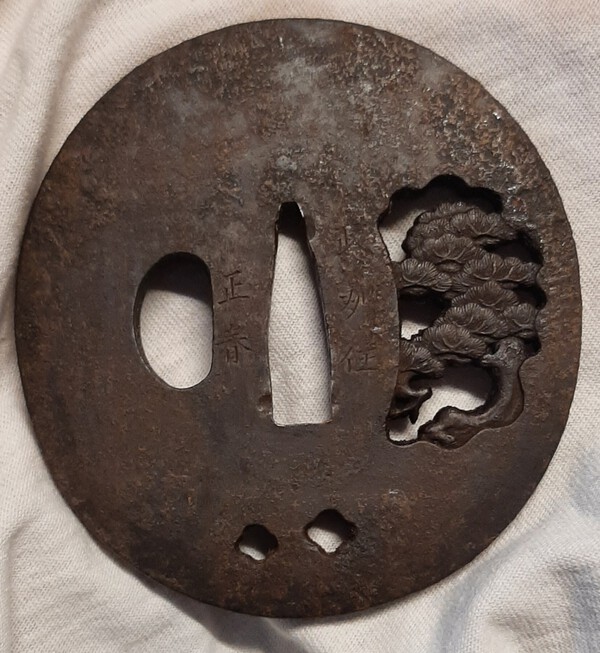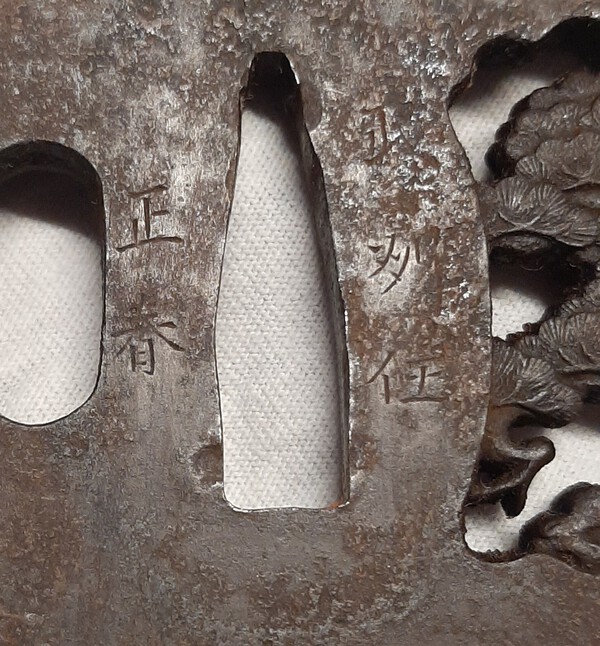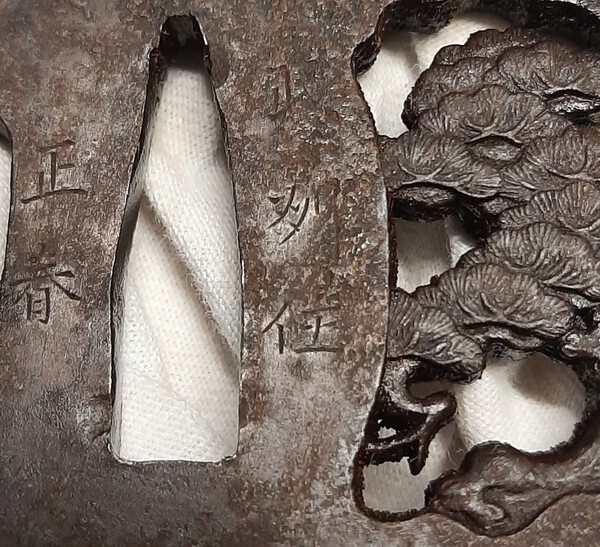-
Posts
592 -
Joined
-
Last visited
Content Type
Profiles
Forums
Events
Store
Downloads
Gallery
Everything posted by Itomagoi
-
Hello, I would like to hear your opinion on this tsuba. Is it an original Japanese tsuba from the edo period or rather a modern tsuba for iaitos? I have not yet found a comparable bamboo tsuba. Maybe this one is also from manufacturers like paul chen, citadel... The tsuba is well made, looks good and I think the signature is Hidefusa 英房? But there is a number 400 stamped on it. I also find remnants of green glue in Nakago ana. That makes me doubt it. If the number is a production run, there must be at least 399 more such tsuba. :-) I look forward to your comments.
-
-
Thank you, Manuel.
-
-

Information about WW2 Smith Ikeda Kunitada
Itomagoi replied to Itomagoi's topic in Military Swords of Japan
August 2603 = August 1943 -

Information about WW2 Smith Ikeda Kunitada
Itomagoi replied to Itomagoi's topic in Military Swords of Japan
A very good idea, Thomas. Chris has taken the time to provide the following information: There was a Kunitada, real name Ikeda Shimeyoshi 池田〆吉 who is listed as a Seki smith. This same person is listed as a student Kato Sukekuni who was in the Kato family of smiths from Meguro, Tokyo, so it is likely he trained with the Kato family and moved to Seki where the demand for smiths and the production of gunto was high. The blade shown below has the Nagoya stamp consistent with blade coming from Seki but the workmanship is more in line with (kesho yasuri-me, etc.) the style of the Kato group than that of those of Seki. He probably didn’t train for very long under Kato Sukekuni as the workmanship seems a little on the crude side. One other piece of the puzzle that indicates that Kunitada worked in Seki: I found the following information concerning a Seki smith, Takaba Makoto: "高羽誠刀匠は、昭和3年2月18日に生まれる。昭和17年、池田国忠刀匠に入門、昭和18年、中田兼秀刀匠に入門する。刀匠銘の「秀忠」は池田国忠刀匠の「忠」と中田兼秀刀匠の「秀」からいただいたものである" It says that the smith Takaba Makoto studied under Ikeda Kunitada in Showa 17, and under Tanaka Kanehide, in Showa 18. He took the mei Hidetaka using a kanji from each of these teachers. Takaba was a Seki smith, as was Tanaka, thus there is no doubt he trained under Ikeda in Seki. My best guess is that Ikeda studied, likely briefly, in Tokyo under Kato Sukekuni, taking the Kuni kanji from Sukekuni for his mei. As I said earlier, his workmanship resembles more closely that of the Kato group than what is commonly seen from Seki smiths in that period. -
Hello, I am looking for some Information about the WW2 smith Ikeda Kunitada. Unfortunately I can't find much about him. CHU SAKU (Kurihara Hikosaburo Akihide), 2nd Seat (6th Shinsakuto exhibition 1941). One of his students was Takaba Hidetada.
-
-
Sure, WA 238. Of course Bruce already has this in his files :-)
-

Japanese Smith smith Ikkansai Yoshihiro
Itomagoi replied to Swords's topic in Swords and Edged Weapons
Ok, all the best for the sale on egun. -

Japanese Smith smith Ikkansai Yoshihiro
Itomagoi replied to Swords's topic in Swords and Edged Weapons
Is this sword still for sale? -
What are the dimensions?
-
Thank you very much, Steve.
-
Bruce, I would, but it's not my sword. Sry. Of course I looked in the pdf of Malcolm "GIFU TOSHO LIST 1937" but no Yoshihiro. If the translation is correct. Google or deepl makes often mistakes in translation.
-
-
Hello, please, I need a correct translation. Google translates 勝善廣 ? as Katsu Yoshihiro ?, but I can't find a Gunto smith with that name.
-

Family line before 1876 and are still active today
Itomagoi replied to Itomagoi's topic in General Nihonto Related Discussion
Thank you for the input. :D -

Family line before 1876 and are still active today
Itomagoi replied to Itomagoi's topic in General Nihonto Related Discussion
I add the Kato line. Kato (Kiyoshi) Kanekuni or Yoshiaki Fujiwara still works today. -

Family line before 1876 and are still active today
Itomagoi replied to Itomagoi's topic in General Nihonto Related Discussion
Thank you very much, Thomas. Thanks for looking, Christian. -
Isn't every bohi cut after forging/hardening like Horimono!? Otherwise the sword is too unstable during hardening and can quickly bend.
-
Hi Bryce, unfortunately I do not know when this habaki was made. Sry.
-

Any Nagamitsu fans out there - one for your perusal.
Itomagoi replied to Beater's topic in Military Swords of Japan
Here is the next one with Katana Mei and Bohi, but wihtout date. Koshirae looks not new. https://www.nipponto...swords4/KY329350.htm



















